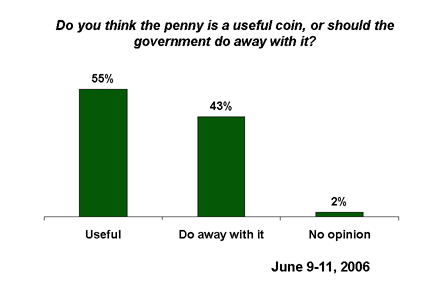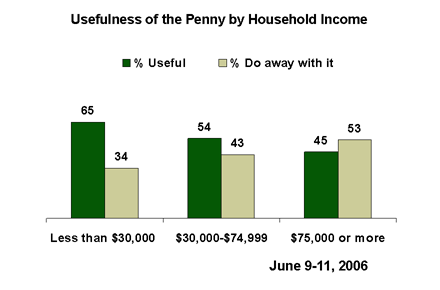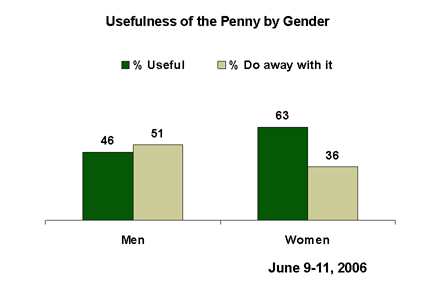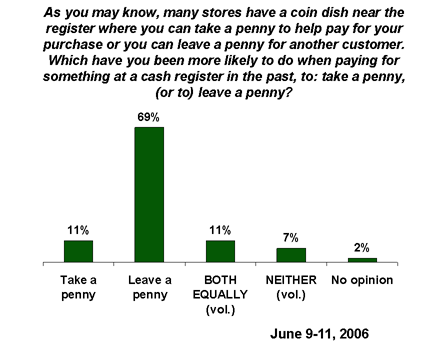GALLUP NEWS SERVICE
PRINCETON, NJ -- Arizona Rep. Jim Kolbe recently announced his plans to reintroduce legislation to slowly phase the penny out of production and circulation in the United States and round purchases to the nearest nickel. Kolbe's announcement comes after the U.S. Mint notified Congress in May that the penny's production will now cost more than the penny is worth. A majority of the American public, however, says the penny is a useful coin, according to a June 9-11 USA Today/Gallup poll. Underscoring this affection for the penny, the poll shows that Americans are more likely to pick a penny up off the ground rather than to leave it.
Is the Penny Useful?
Overall, 55% of Americans say the penny is a useful coin, while 43% say the government should do away with it.

Over the last 13 years, Americans have grown somewhat less likely to see the penny's usefulness. A September 1993 ABC News poll found that 64% of Americans said the penny was a useful coin, while 33% said the government should do away with it.
The current poll finds some differences in attitudes toward the penny across various demographic groups, particularly among household income and gender groups.
- Sixty-five percent of adults in low-income households (those earning less than $30,000 annually) say the penny is a useful coin. This percentage drops as income increases, with 54% of those in the middle-income category (those earning between $30,000 and $75,000) saying the penny is useful, and only 45% of those in the high-income group (earning $75,000 or more per year).

- More than 6 in 10 women, 63%, say the penny is useful, while 36% say the government should do away with it. Men are much more divided, with 46% saying the penny is useful and 51% saying it should be done away with.

- Nonwhites are more inclined than whites to say the penny is useful, at 65% vs. 52%.
- There are few differences by age, with the percentage saying the penny is useful at 57% for those aged 18 to 34, at 55% for those aged 35 to 64, and at 52% for those aged 65 and older.
- Fifty-nine percent of Democrats say the penny is a useful coin, just slightly higher than among independents (53%) or Republicans (51%). The results are similar by self-described political ideology, with 55% of conservatives, 56% of moderates, and 51% of liberals expressing this sentiment.
Historically, Americans have always thought the penny is useful and should remain in circulation, even though, as noted, the percentage who finds the penny useful appears to have dropped in recent years. Numerous polling firms have asked about this subject over the years, and consistently, a majority of Americans support the production and use of the penny.
Americans See a Penny, Pick It Up
The poll asked Americans what they typically do when they encounter pennies in two situations -- when they see one on the ground and when they are at a cash register that has a nearby dish for leaving or taking pennies.
By a 76% to 23% margin, Americans say they are more likely to pick a penny up off the ground rather than to leave it.

While a majority of Americans in all income categories say they are more likely to pick a penny up off the ground rather than to leave it, it is perhaps not surprising that this behavior is somewhat more common among those in lower-income households than among those in higher-income households. The percentage saying they stop to pick up a penny is 86% for those in the low-income group, 76% for those in the middle-income group, and 65% for those in the high-income group.
By a 14-point margin (83% to 69%), women are more likely than men to say they pick a penny up off the ground.
Nearly 7 in 10 Americans (69%) say they leave a penny in a coin dish near a cash register for other customers to use, while 11% say they take a penny to help pay for their purchases. Eleven percent volunteer that they are equally likely to leave or to take a penny, and 7% volunteer that they do neither. The poll finds little difference by demographic subgroups on this particular measure.

Survey Methods
These results are based on telephone interviews with a randomly selected national sample of 1,002 adults, aged 18 and older, conducted June 9-11, 2006. For results based on this sample, one can say with 95% confidence that the maximum error attributable to sampling and other random effects is ±3 percentage points. In addition to sampling error, question wording and practical difficulties in conducting surveys can introduce error or bias into the findings of public opinion polls.
